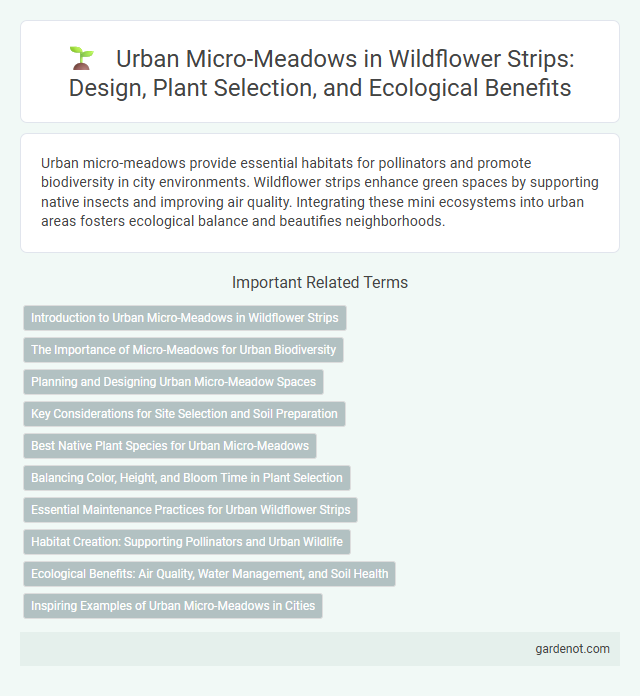Urban micro-meadows provide essential habitats for pollinators and promote biodiversity in city environments. Wildflower strips enhance green spaces by supporting native insects and improving air quality. Integrating these mini ecosystems into urban areas fosters ecological balance and beautifies neighborhoods.
Introduction to Urban Micro-Meadows in Wildflower Strips
Urban micro-meadows in wildflower strips create biodiverse habitats by incorporating native flowering plants within compact spaces. These micro-meadows enhance pollinator activity, improve air quality, and support urban ecosystem services. Strategic planting in urban environments fosters ecological resilience and green connectivity.
The Importance of Micro-Meadows for Urban Biodiversity
Urban micro-meadows act as crucial biodiversity hotspots by providing habitat, food sources, and breeding grounds for pollinators such as bees, butterflies, and native insects. These wildflower strips enhance ecological resilience within city landscapes by supporting diverse flora and fauna, improving air quality, and promoting soil health. Incorporating micro-meadows into urban planning fosters sustainable green spaces that mitigate urban heat islands and contribute to overall ecosystem balance.
Planning and Designing Urban Micro-Meadow Spaces
Urban micro-meadow planning involves selecting native wildflower species adapted to local soil and climate conditions to enhance biodiversity and support pollinators. Designing these small-scale green spaces requires careful consideration of sunlight exposure, drainage, and the integration of pathways to balance ecological function with public access. Incorporating layered plant structures and seasonal bloom cycles maximizes habitat value and aesthetic appeal in urban environments.
Key Considerations for Site Selection and Soil Preparation
Urban micro-meadows thrive in locations with ample sunlight exposure, typically receiving at least six hours of direct sun daily to support diverse wildflower growth. Soil preparation should include testing pH levels to ensure a slightly acidic to neutral range (6.0-7.0), with organic matter amendments to enhance drainage and nutrient content. Removing existing turf and weeds prior to seeding promotes successful establishment and reduces competition for resources.
Best Native Plant Species for Urban Micro-Meadows
Choosing the best native plant species for urban micro-meadows ensures ecological resilience and supports local biodiversity. Species such as Solidago canadensis (Canada goldenrod), Echinacea purpurea (purple coneflower), and Asclepias tuberosa (butterfly weed) thrive in small urban spaces, providing nectar sources for pollinators and enhancing soil health. Incorporating native grasses like Schizachyrium scoparium (little bluestem) promotes structural diversity and drought tolerance in wildflower strips.
Balancing Color, Height, and Bloom Time in Plant Selection
In urban micro-meadows, carefully balancing color, height, and bloom time in wildflower strip plant selection enhances visual appeal and ecological benefits. Combining early, mid, and late-blooming species like Black-eyed Susan, Purple Coneflower, and Goldenrod ensures continuous pollinator support. Integrating short and tall plants such as coreopsis and switchgrass creates layered habitats, promoting biodiversity and aesthetic harmony.
Essential Maintenance Practices for Urban Wildflower Strips
Urban wildflower strips require regular watering, especially during dry spells, to ensure healthy growth and vibrant blooms. Periodic mowing, ideally once or twice a year, helps prevent woody plant encroachment and promotes biodiversity by encouraging native wildflower regeneration. Removing invasive species manually or with targeted herbicides maintains ecological balance and supports pollinator habitats within the urban micro-meadow.
Habitat Creation: Supporting Pollinators and Urban Wildlife
Urban micro-meadows, such as wildflower strips, play a crucial role in habitat creation by providing essential food sources and shelter for pollinators like bees, butterflies, and other beneficial insects. These habitats enhance biodiversity within city landscapes, supporting urban wildlife and promoting ecological balance. Establishing wildflower strips contributes significantly to the conservation of pollinator populations, which are vital for urban ecosystem health and sustainability.
Ecological Benefits: Air Quality, Water Management, and Soil Health
Urban micro-meadows, such as wildflower strips, enhance air quality by absorbing pollutants and producing oxygen through diverse plant species. These green spaces improve water management by reducing runoff and increasing water infiltration, mitigating urban flooding risks. Soil health benefits from organic matter accumulation and microbial activity stimulated by native wildflowers, promoting nutrient cycling and soil structure stabilization.
Inspiring Examples of Urban Micro-Meadows in Cities
Urban micro-meadows transform small city spaces into vibrant habitats, boosting biodiversity and enhancing local ecosystems. Notable examples include London's Queen Elizabeth Olympic Park and New York's High Line, where wildflower strips create colorful, pollinator-friendly environments. These installations demonstrate how integrating native wildflowers in urban planning supports sustainable city living and community well-being.
Urban micro-meadow Infographic

 gardenot.com
gardenot.com